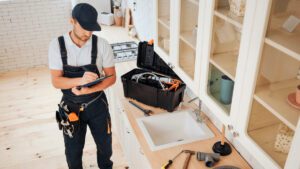As a property preservation contractor, it’s important to be aware of the potential safety hazards that may be present at REO properties. In this blog post, we’ll discuss some common safety hazards and provide tips on how to address them.
Read Work Orders Carefully
Before beginning any work on a property, make sure to read the work order carefully. Each client may have different requirements when it comes to addressing safety hazards, so it’s important to pay attention to the details.
Common Safety Hazard Locations
The following are common areas where safety hazards may be found:
- Windows
- Electrical and/or gas items
- Stairways
- Floor
Windows
When it comes to windows, it’s important to inspect each one, including doors, for broken glass and cracks. Any broken glass must be completely removed from the frames, sills, and ground. If any portion of a window is cracked, tape it with clear tape only. If a window has a large crack or chip that is allowing elements or animals to enter the home, all the glass must be removed. The window should be boarded up, and a bid must be submitted to reglaze the window.
To prevent unwarranted entry to the home, ensure that all ground-level windows are locked or not accessible from the exterior. If a window is nailed shut from the interior or painted shut and secured, there’s no need to add window locks.
Electrical and/or Gas Items
To prevent electrical accidents, ensure that all electrical outlets have switch plates or outlet covers, and there are no exposed wires. If there’s no switch or plug in a junction box and just wires, cap the wires and tuck them into the junction box.
Check the gas connection where no appliance exists, and cap it whether the gas is on or off. Use rolling Teflon tape or put paste on the pipe to prepare it for capping. This helps seal the threads in case someone does not turn on the gas. Put the gas cap on, making sure it’s snug, by using a pair of channel locks or a pipe wrench. When finished, the cap should be tight, and the valve should be in the off position.
All standard-sized light bulbs at the property must be functioning properly, including lights in the attic, basement, garage, outbuildings, and any on the exterior of the property. However, this only applies to standard size light bulbs and does not include candelabra, fluorescent, or halogen lights.
Take any necessary action to re-secure all loose fixtures or ceiling fans that are hanging. Cords that are attached to the property, such as cable cords, telephone lines, or speaker wires, should be rolled and tied. Any low or loose hanging wires in the basement area, crawl spaces, or attics need to be zip-tied. Wrap the zip-tie around the wire and anchor it to the ceiling, then clip the tail off of the zip tie. Continue adding zip ties down the length of the wiring until it’s completely secure.
Breaker panel covers must be installed. If wires are exposed, as long as the wires are not exposed and covers are installed on the individual breakers, there’s no need to install a door if one is not present. If the panel is in place but breakers are missing, individual breaker covers are required to be snapped into place on the cover.
Stairways
All stairways with three or more treads must have a single handrail present. Install brackets on the handrail before installing it on the wall. You want to make sure you have an adequate number of brackets on the railing to provide support all the way down the stairs. A bracket should be at least every three feet. Line up the handrail on the wall and then play screws through all the holes of all brackets. If you do not hit a stud with the screws, drill in anchors to ensure the handrail is secure. If the side opposite from the handrail has an opening of 24 inches or greater, you must install a guardrail to prevent children from falling.
Ensure all steps, both inside and outside the property, are secure, weight-bearing, and in compliance with local ordinances. If there is no way to post up a railing without causing damage to decorative columns or brick at front entries, contact the broker prior to installation. If the broker decides against the installation of handrails or safety rails, upload the broker’s written confirmation with your update.
Floor
All floor registers and vent covers must be present. If a cover is missing, try and replace it with a new cover. If the opening is a custom size and cannot be found, the opening must be boarded. Any loose flooring that can be considered a trip hazard should be tacked down. An area that is 6 inches or greater of torn carpet or torn linoleum requires repair.
Being aware of potential safety hazards is crucial to ensuring the safety of oneself and others. This blog post has outlined some common areas where safety hazards may be present, such as windows, electrical and gas items, stairways, and floors, and provided tips on how to address them. By following these guidelines and always prioritizing safety, property preservationists can take the necessary steps to secure a property and prevent accidents or injuries. It’s important to read the client’s work order carefully and follow their specific requirements to ensure that all safety hazards are identified and addressed appropriately.

